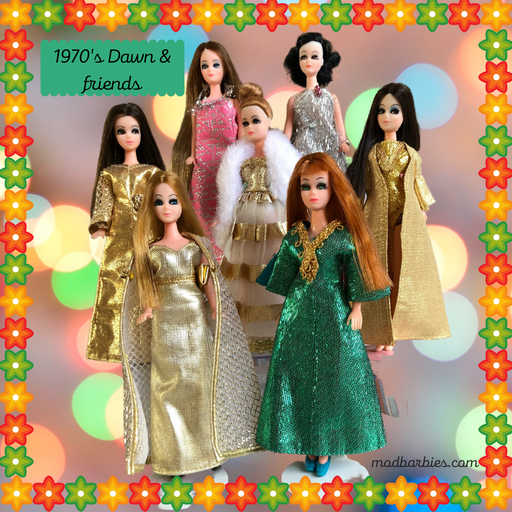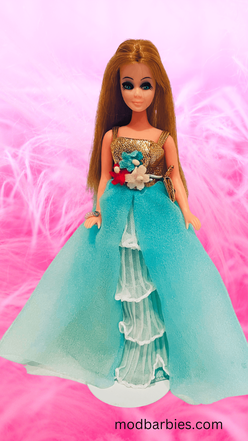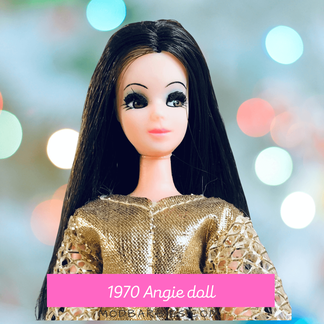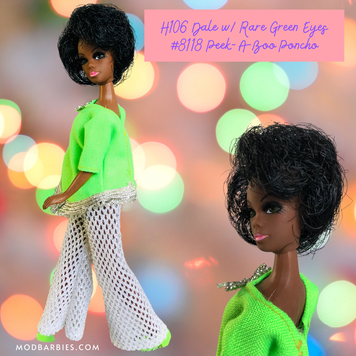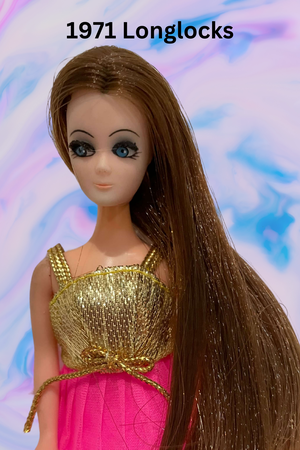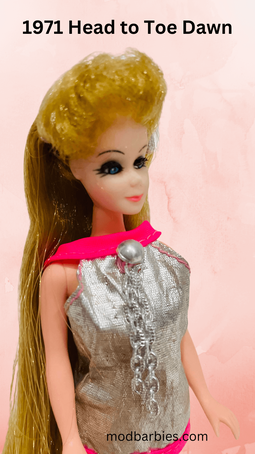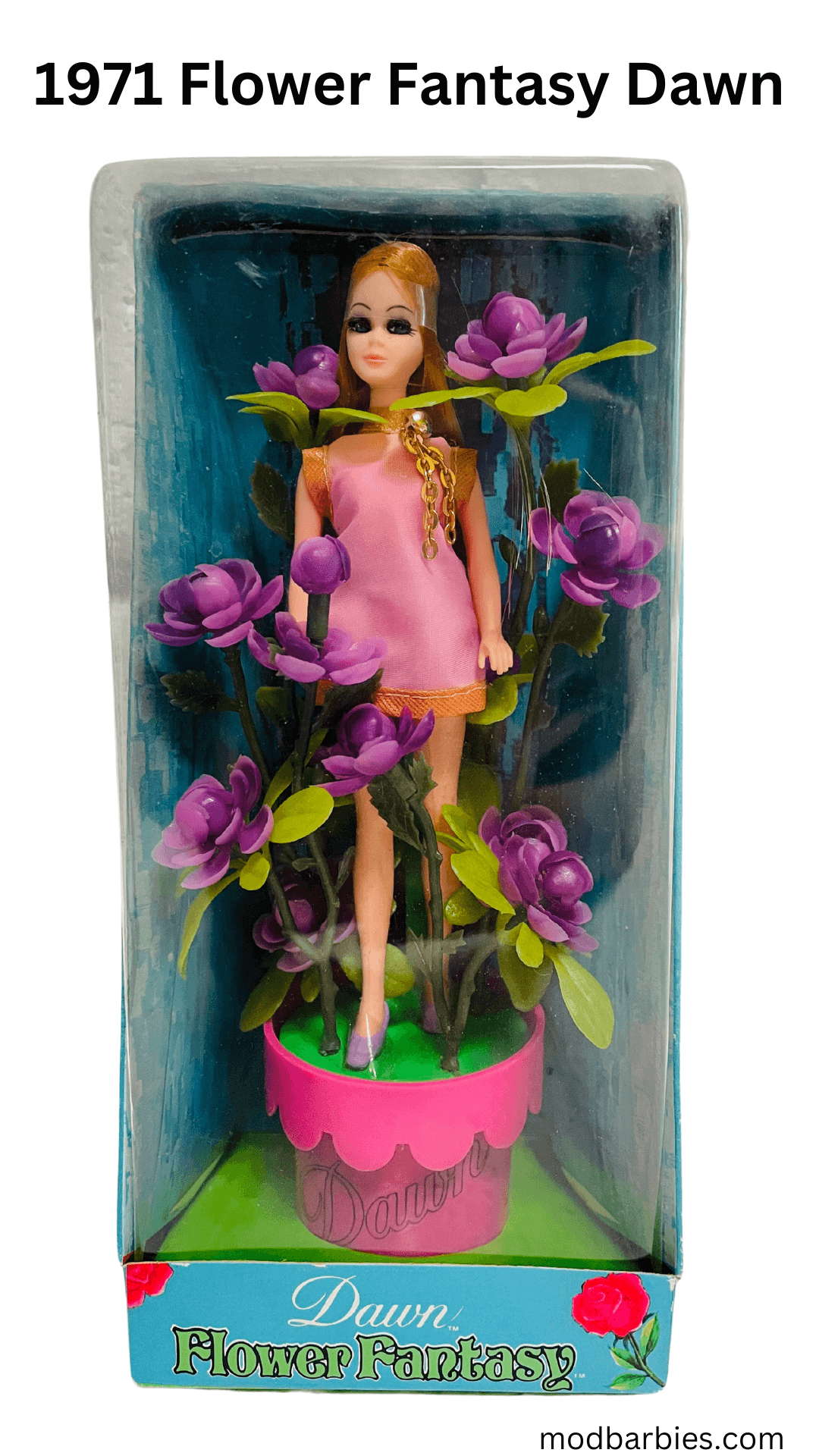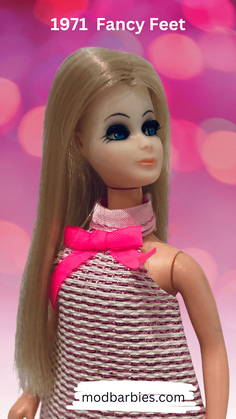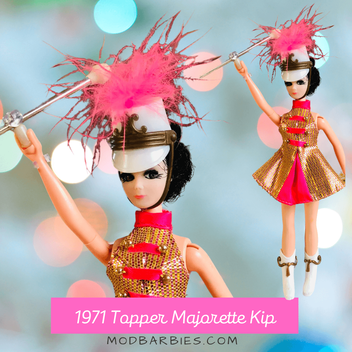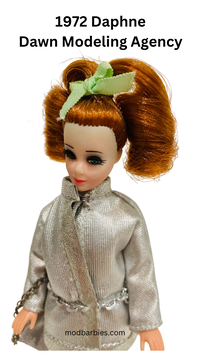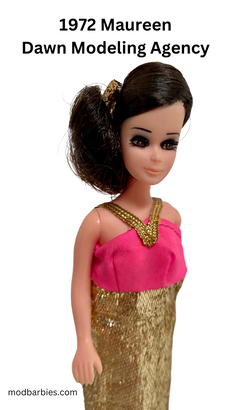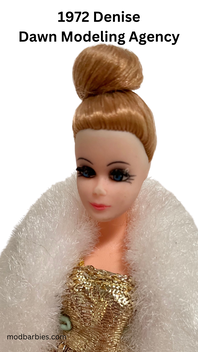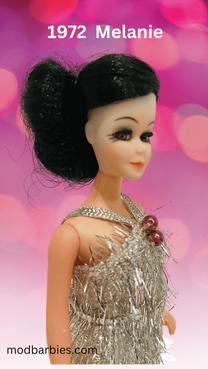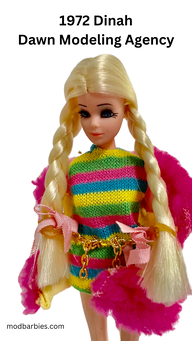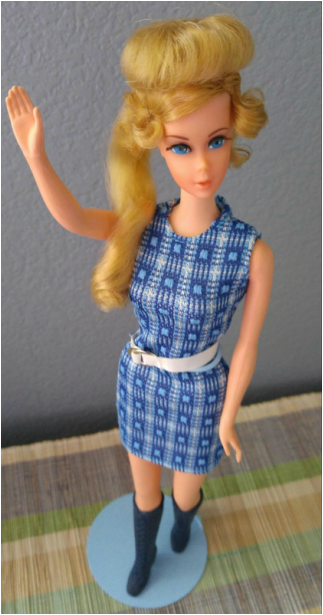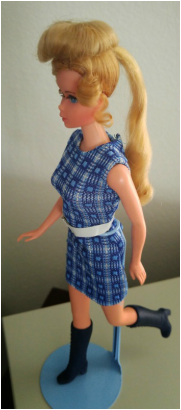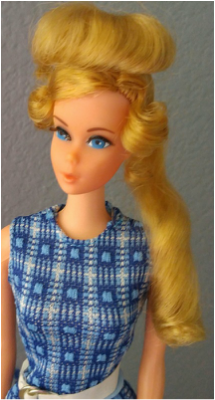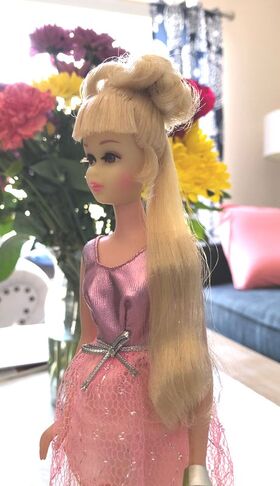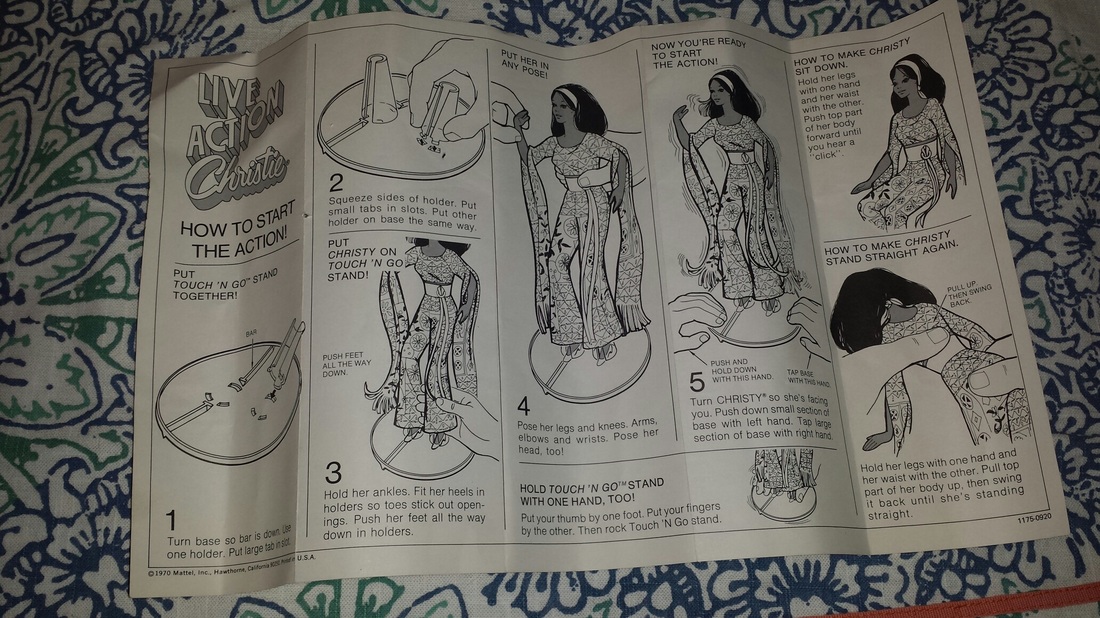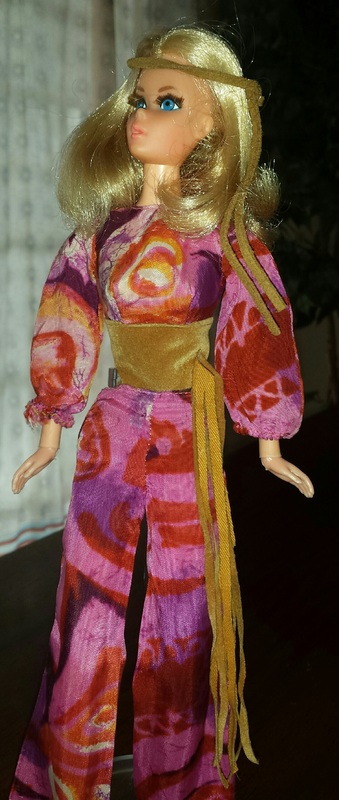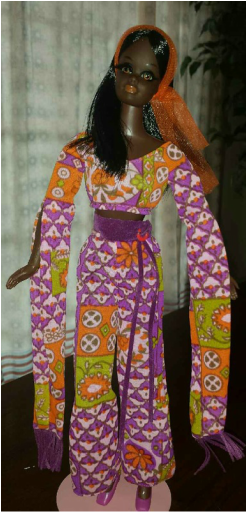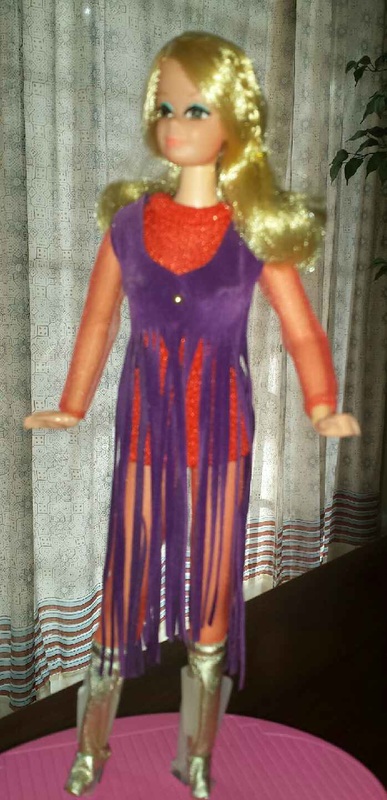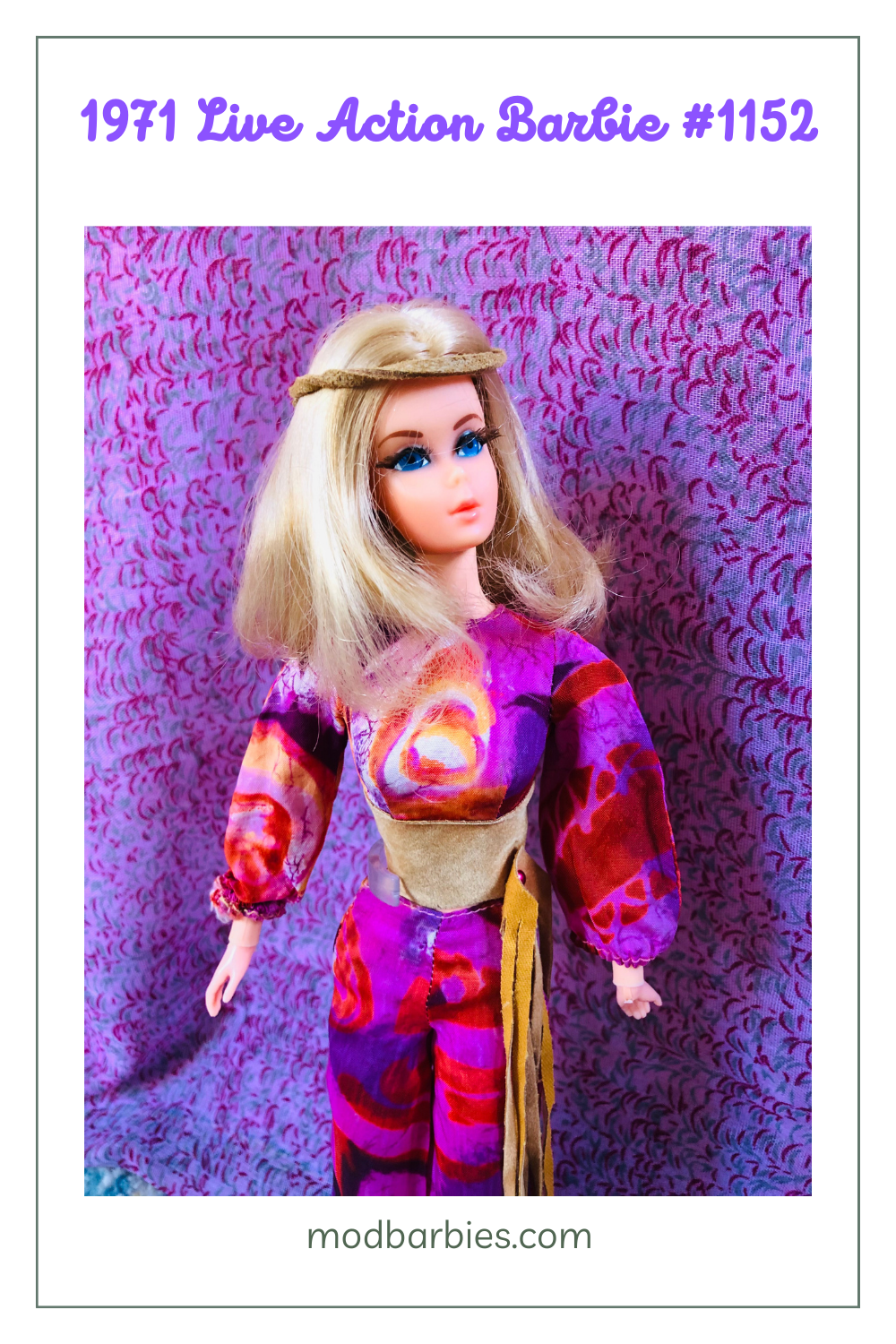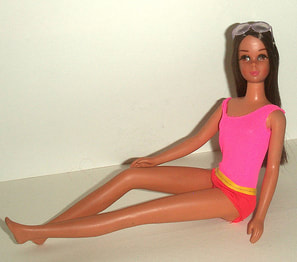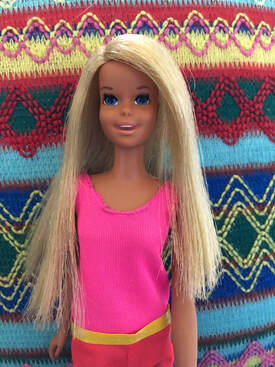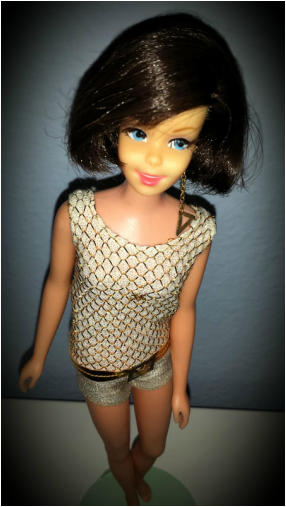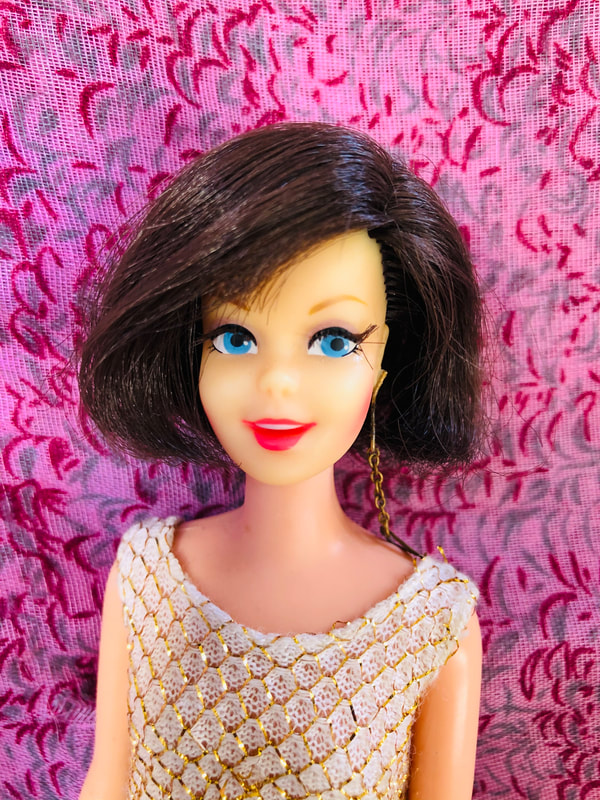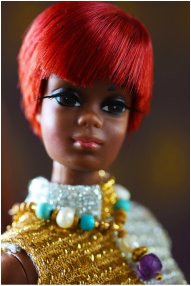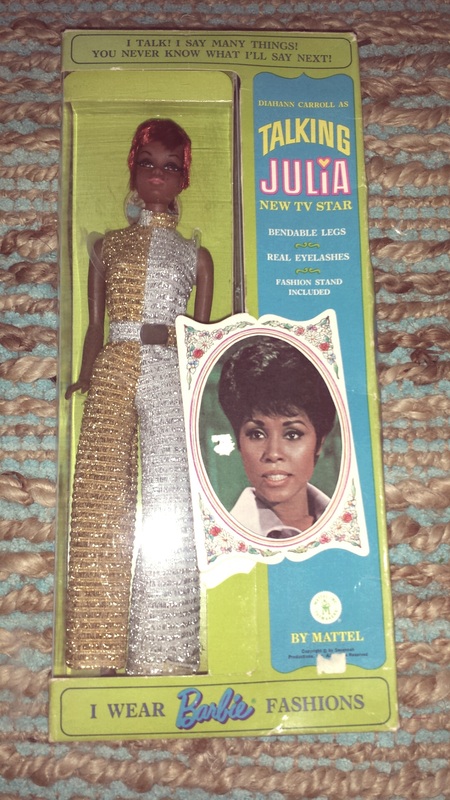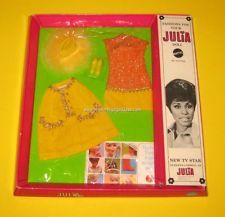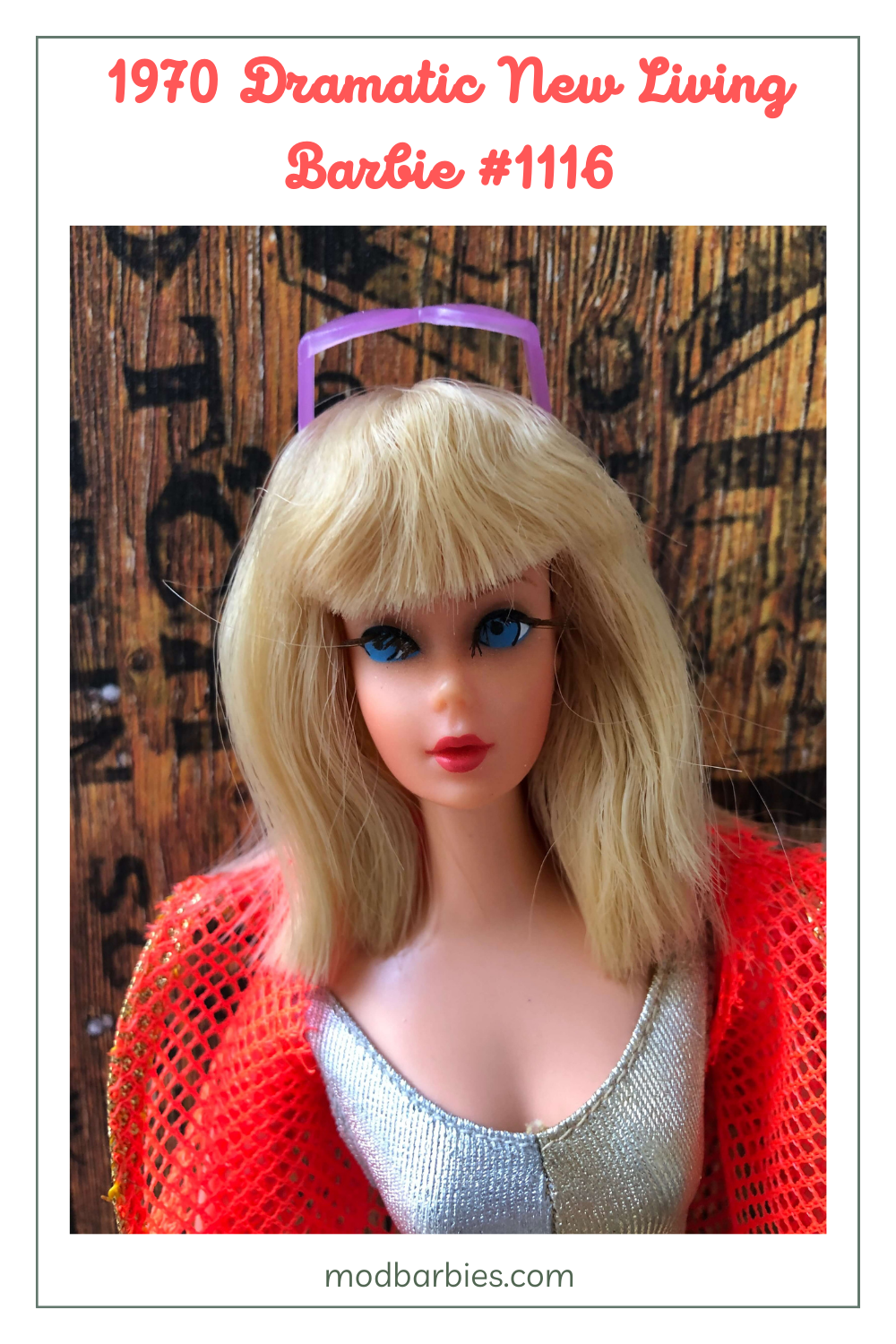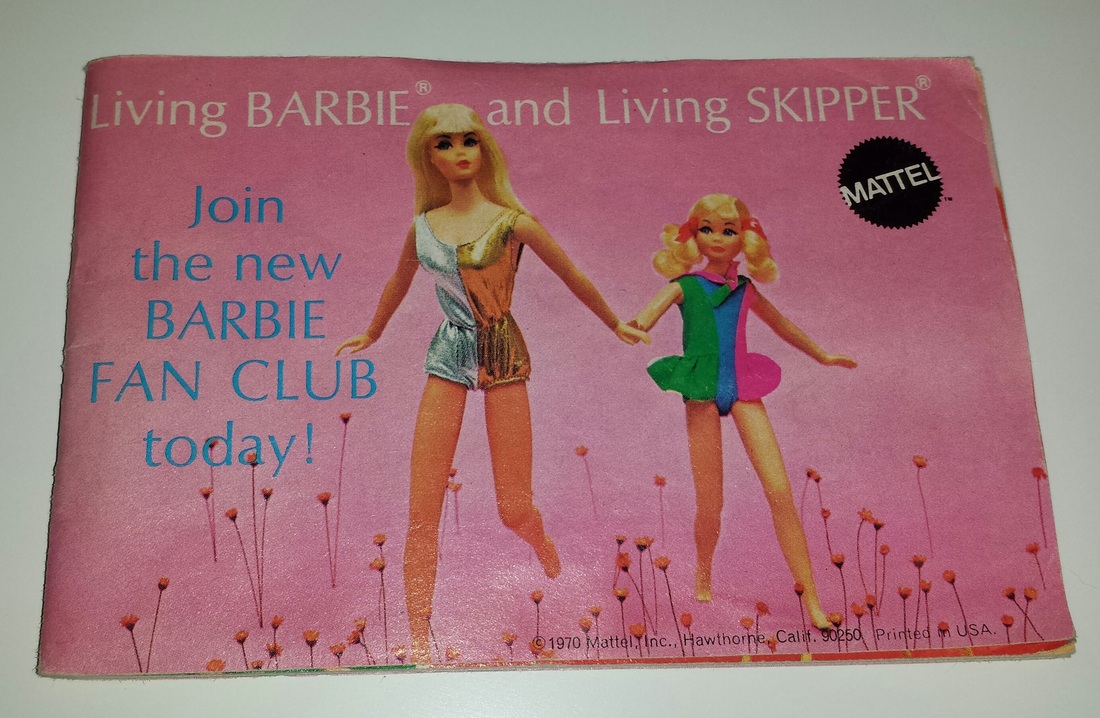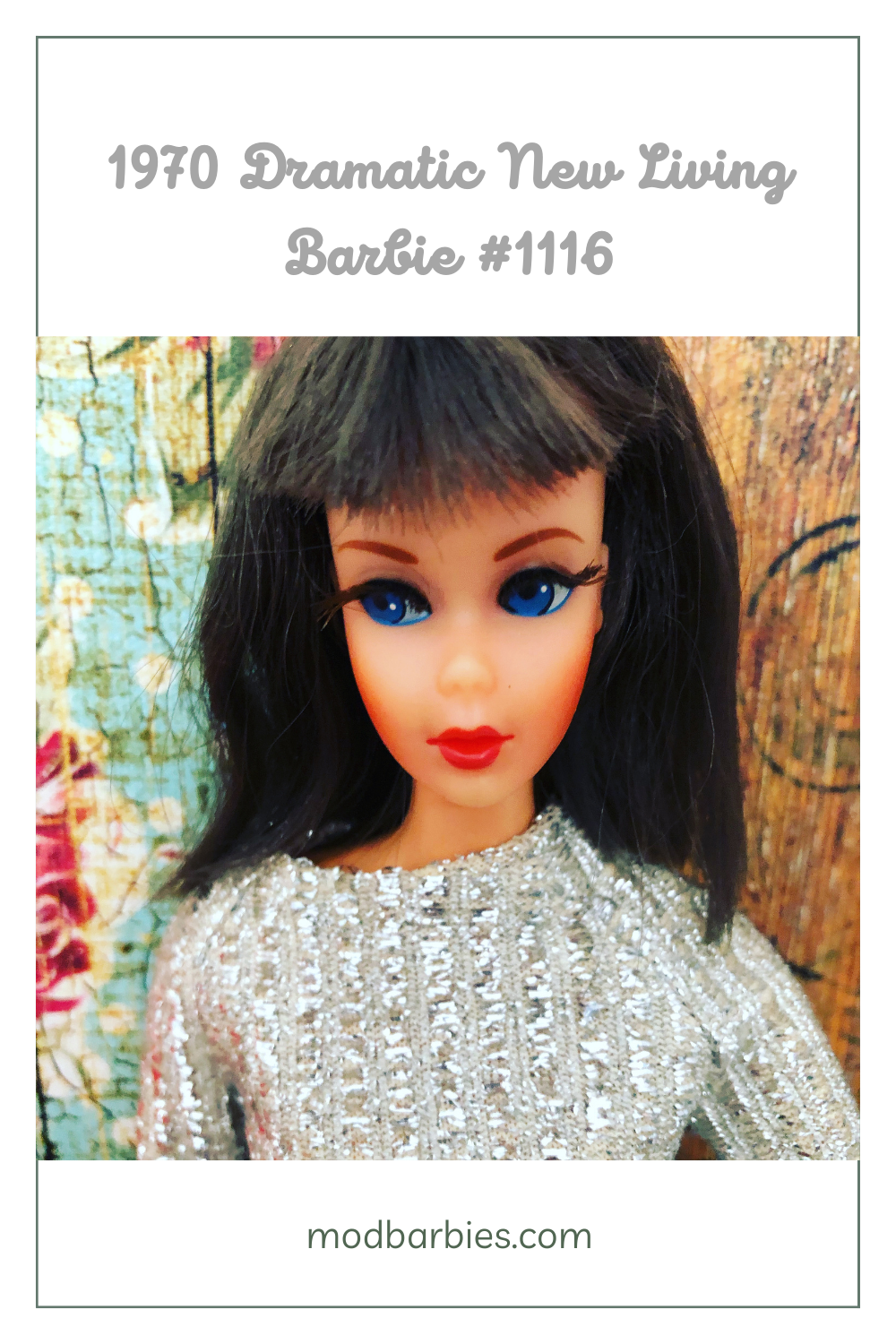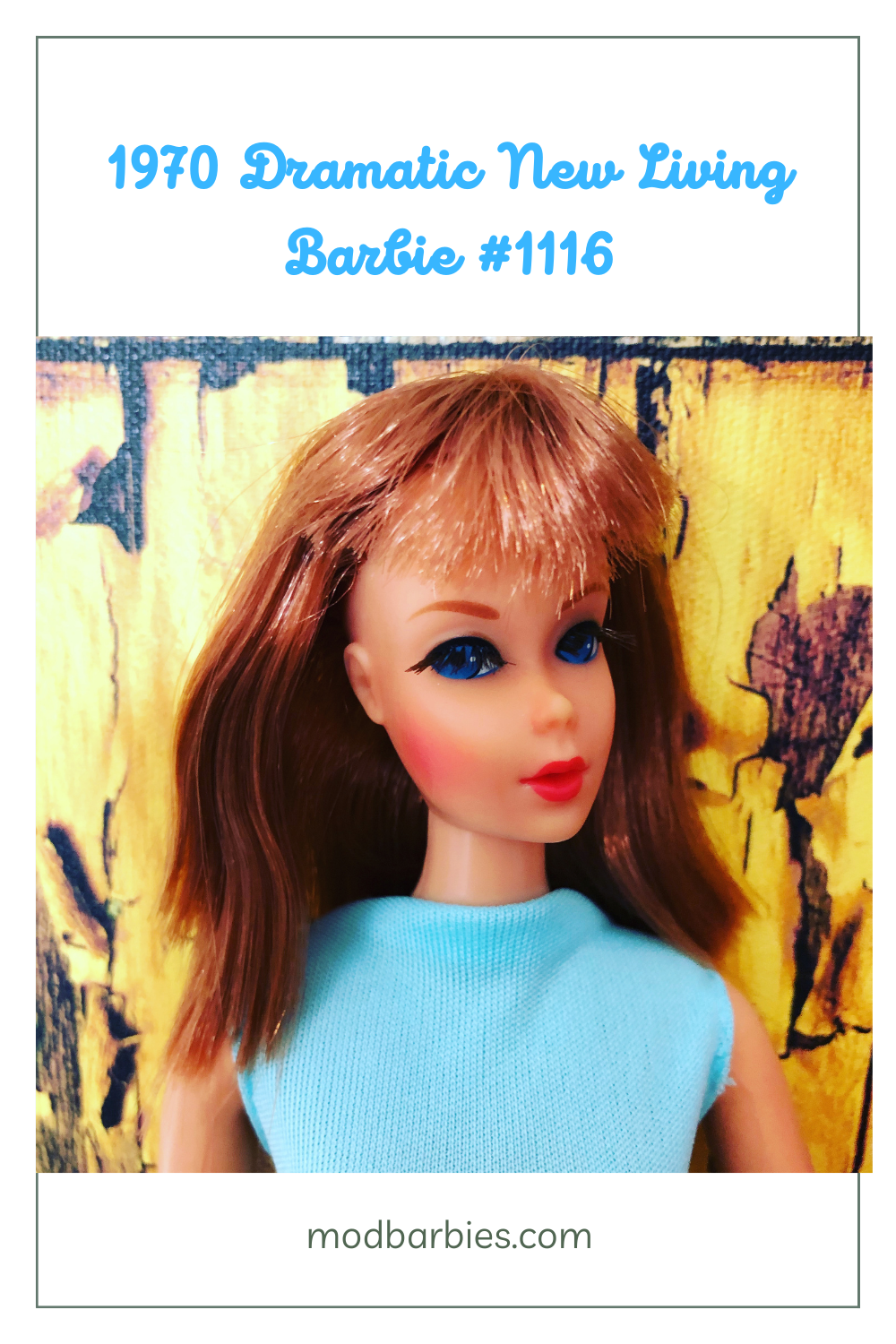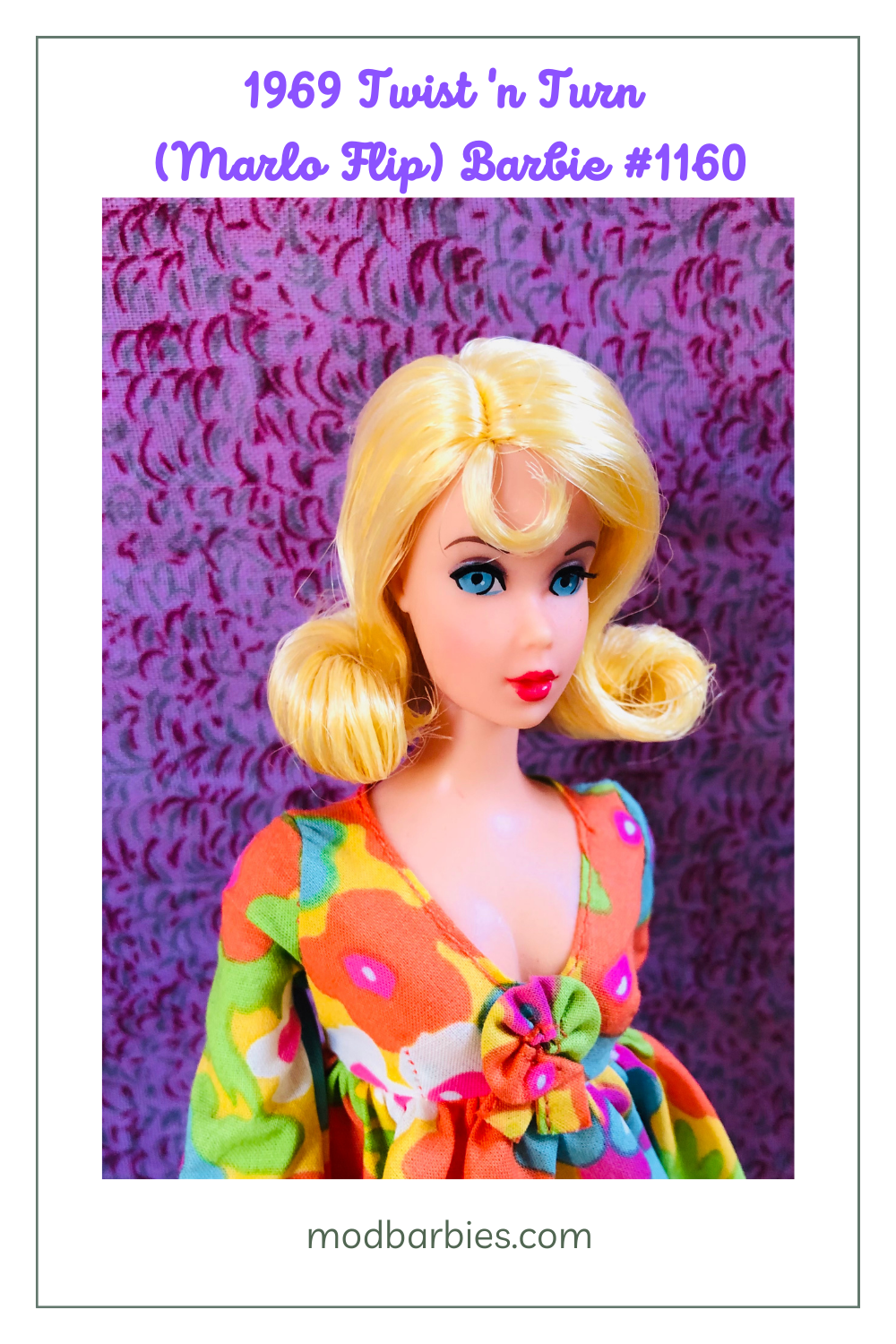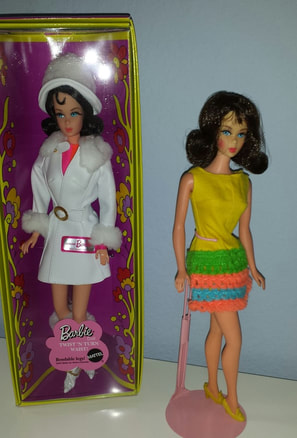|
Blog post updated OCTOBER 2023
If you enjoyed playing with Mod Barbies as a child, you probably remember the tiny doll stars of the early '70s, Topper's Dawn dolls. Topper Toys released Dawn dolls in March 1970. Compared to Barbie, these dolls were much smaller at 6 1/2" tall. Like Barbies of that era, they had rooted hair and rooted eyelashes. Three friends of Dawn were also released in 1970 - her girl squad Angie, Glori and Dale. Dawn and her besties were glamorous fashion model dolls with the most beautiful fashions. The initial line included 44 groovy outfits. The (anything but!) basic Dawn was a blonde-haired, blue-eyed doll with straight, waist-length hair parted in the middle. Her eyes glance to the left but there are some variations including brown-eyed Dawn dolls, side-parted hair, strawberry blonde hair and eyes looking forward or towards the right. Dawn's friend, brown-eyed girl Angie, also had waist-length straight hair but in a dark brown shade.
Dale is a groovy African-American doll with brown eyes and a black bubble cut hairdo, very popular in that era. Dale variations include many different eye colors and different lip colors. My favorite Dale has the rare green eyes - which I have in my collection.
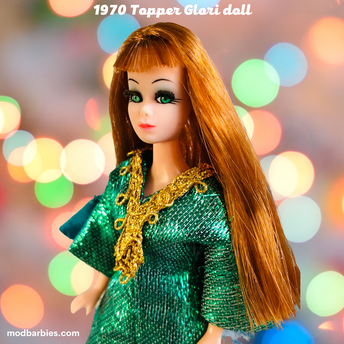
Another gal pal of Dawn's, Glori, is most commonly a redhead with straight, waist-length hair and cute bangs. Some Glori dolls have side-parted straight, waist-length hair without bangs and others have side-parted curly or wavy hair. Other Glori variations have blue eyes or no bangs.
The second wave of Dawn dolls in 1971 included three men: Gary, Ron and Van, plus Jessica the flight attendant and Longlocks with, you guessed it, long hair! Jessica had short side-parted blonde hair (I need to add her to my collection so I don't have a photo of her) and Longlocks showed off her extra-long auburn center-parted hair that went below her waist. Also in 1971, Head to Toe Dawn was introduced. These cuties had a short bubble cut hairstyle with bangs and came with wigs; a floor-length fall, a sausage-curled ponytail and a long braid. Head to Toe dolls became so popular that in the following year, 1972, Head to Toe Angie and Head to Toe Longlocks were introduced. These dolls were inspired by Crissy and Velvet dolls who had hair that "grew" from the tops of their heads. I had Crissy and loved playing with her hair! 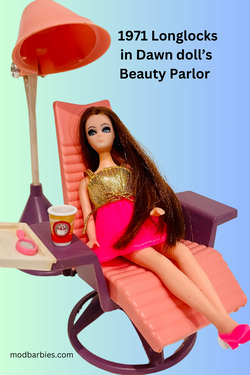
The dancing doll line included Dawn, Angie, Glori, Dale, Longlocks and Jessica. Dawn's Dance Party set came in three options: First, Dawn's Dance Party featuring Fancy Feet (see her above) and secondly, Dawn's Dance Party featuring her boyfriend, Dancing Kevin. The third set, Dawn's Double Dance Party, included both Fancy Feet and Kevin. Alternatively, the two single sets could be attached to form its own double stage! The stage was battery-operated and had a handle of the side so the doll could move around on the stage. The dance party stage is yellow hard plastic with a pink, blue, yellow and white polka dot stage. Click here to find your Dawn doll on eBay!! 1971 Flower Fantasy dolls are hard to find so mint in box dolls are highly sought after by collectors today. I have one in my collection that is so pretty (see above). There were four styles; a yellow pot with red flowers, pink pot with pink roses, blue pot with orange and yellow flowers and a pink pot with purple flowers (this is the one I have). Only Dawn dolls accompanied the flowers, not any of her friends. Dawn had a plethora of fun play sets. The most popular set was 1970's Dawn's Fashion Show. Dawn and her friends sashayed down the battery-operated revolving stage. The girls could practice modeling the latest fashions on the runway. Dawn had an aqua Action Car that could do turns. Dawn's Beauty Parlor play set (see left photo) kept Dawn looking her best. Dawn also had a Music Box and the Dawn 'N Me Pocketbook which was a purse with a long gold shoulder chain. If Dawn was inserted correctly, her head peeked out from a sliding window on the front. Dawn introduced 8 new play sets in 1971: Dawn's Beauty Pageant which allowed the dolls to walk the runway, turn and walk back along the other side. Also introduced was the DeLuxe Beauty Pageant (added a gold cape and Gary doll dressed in a tux), Dawn's Dance Party (3 versions), Dawn's Dress Shop, Dawn's Floral Stand, and Dawn's New Car in hot pink with flowers. The last run of Dawn dolls was in 1972 which introduced two collections - the Majorette Dawn dolls and the Dawn Modeling Agency dolls. The Majorettes included Dawn, Kip and Connie (originally named April). The bodies were made with a set of hard plastic arms that would stay straight and help the doll twirl her glow-in-the-dark baton. Maybe these dolls inspired me to be a Twinkie Twirler when I was 5 years old back in the day, haha!
The 1972 Dawn Modeling Agency dolls are among my favorites. There were five different dolls with unique hairstyles and fancy clothes that oozed glamour. Each model came with an evening bag, jewelry and a plastic portfolio that was color-coordinated to match their outfit. Each portfolio held a strip of 6 black and white photos of the model.
Daphne is a redhead with her hair in a pony with two sausage curls. Denise is a blonde with her hair in a bun on the top of her head. Dinah is a platinum blonde doll with two long braids tied with pink ribbons.
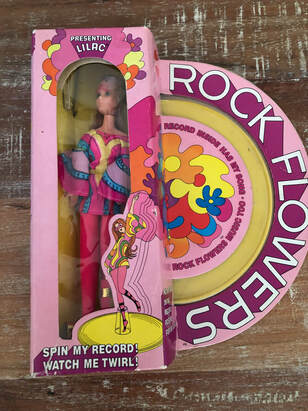
Initially, Dawn dolls were very popular because Topper invested heavily in TV advertising, the dolls were easy for retailers to display, while the low price attracted the consumer. Also, at this time, Barbie sales weren't doing that great. She was suffering from an identity crisis and her quality wasn't as good as earlier years. Think Malibu Barbie vs Twist 'n Turn Barbie!
Sadly, Dawn Dolls were discontinued in 1973. They had a good run for a few years anyway! Dawn's popularity was short-lived because Topper went bankrupt in 1973 and they were not able to innovate such a small doll. Checkerboard Toys reissued the dolls in 2000 making reproductions of Dawn, Glori, Angie and Dale as a 30th year anniversary commemoration. Checkerboard also released three new dolls in addition to Dawn; redhead Shannon (aka Maura), brunette Macy and African-American Denise in a line called Fab Fashions Fun. Their catchphrase was, "It's Groovy to be a Girl!" Then there were the Karma Cool Dawn dolls (Dawn, Denise and Macy. There was Shannon. She must have left town haha). They had super-long hair with colorful streaks. Dawn, Macy and Denise also came out in Go 'n Glo versions. Checkerboard produced other Dawn dolls too; bridal and holiday dolls, and special edition dolls like Totally Golden Macy and Seriously Silver Dawn dolls (photo from my collection). The dolls didn't really catch on and, due to a lagging economy, Checkerboard made its last Dawn dolls in 2003. Toy-O-Rama (the re-organized Checkerboard Toys) tried to revive the Dawn dolls in 2004 by repackaging the liquidated Checkerboard dolls but it was short-lived. The advent of eBay catapulted Topper Dawn back into the consciousness of the youngest Baby Boomers and the oldest Gen Xers, referred to as Generation Jones (that would be me!). The Gen Jones are born from 1954 to 1967 and became the target market for Dawn dolls. In 1972, England's Palitoy produced Pippa, another pocket-sized doll who looked shockingly similar to Dawn. Some refer to her as Dawn's British cousin! They produced over 30 different Pippa and friends. Her first three friends were Marie, Tammie, and Britt. To reflect Britain's diverse ethnic population, Pippa later had an Asian friend named Jasmine and an African-American girlfriend, Mandy. More friends were added to the line - Gail (she looks like a small Malibu Barbie!), Emma, Rosemary, Penny and boyfriend Pete. The Pippa line outlived Dawn by seven years. In 1971, Mattel produced Rock Flower dolls in response to Dawn dolls' popularity, but they came nowhere near Dawn doll sales. The squad including Lilac, Rosemary, Iris, Doug and Heather. Each doll came with a 45 record. The records featured a solo song written for each doll with the flip side showcasing a group performance. The line was discontinued in 1974. If you love Dawn and collecting her, there are many groups on Facebook - just search on Topper Dawn Dolls. There is also an annual Dawn Doll Convention. Which were your favorite Dawn Dolls?! Would love to hear from you. Talk soon, dolls! xo, Lynne Stop by my influencer Amazon storefront at amazon.com/shop/influencer-e50a405a! I receive a commission from Amazon. #dawn #angie #dale #glori #dawndoll #vintagedawn #70sdawn #dancingdawn #headtotoe #longlocks #jessica #flowerfantasy #modelingagency #fancyfeet #daphne #melanie #maureen #denise #70sdolls #majorettes #kip #pippa #topper
Sources: The Dawn Spot, A Little Bling and The Spruce
18 Comments
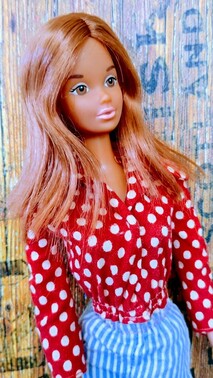 1974 Yellowstone Kelley doll #7808 1974 Yellowstone Kelley doll #7808
1974’s Yellowstone Kelley (#7808) was one of my favorite Barbies to play with as a young girl. I loved her tan, her cute pink lips and pretty red, shiny hair! She remains a difficult doll to acquire. Mattel used the very popular Steffie head mold for Kelley. She came with blue and white striped camping shorts and pants, a red and white dotted shirt and adorable knee-high socks with sneakers. Kelley also came equipped with lots of fun gear to go on her camping adventures; a backpack, yellow sleeping bag, camping mattress, camp stove, cooking utensils, pots and pans and a brush and comb because a girl can only “rough it” so much!
Barbie dolls in 1974 were a shout-out to sports and physical activity. With the ‘76 Olympics just two years away and sports more popular than ever, Mattel created a Barbie sport series called the Sports Set. These dolls camped, sailed and skied their way into the hearts of children. There were only four sets of these active teens made; sailing Newport Barbie, skiing Sun Valley Barbie and Ken and camping Yellowstone Kelley. She was the only “new” doll in this line, as Sun Valley Barbie and Ken and Newport Barbie were 1973 Malibu dolls just dressed in sports fashions (sneaky!). The only other Kelley (Barbie) doll produced was Quick Curl Kelley #4221 from 1973 - 1976. Barbie’s clothing in 1974 was influenced by the economic times and were less elaborate, featuring the Best Buy Barbie Fashions. Depends on who you ask, but many think 1974 was the last year of the “Mod” Barbie. I could also see it as 1972 or ‘73 when you consider their hairstyles and fashions. What do you think? xo, Lynne Click here to find your Yellowstone Kelley on eBay!! 1972 Yellowstone Kelley (#7808)
#kelleybarbie #70skelley #yellowstonekelley #yellowstonebarbie #kelleydoll #70sbarbies 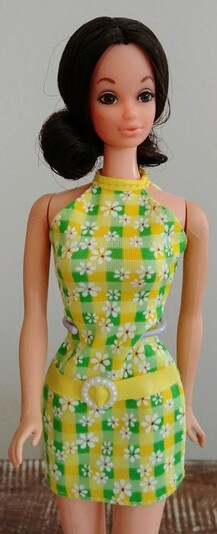 1972 Walk Lively Steffie #1183 1972 Walk Lively Steffie #1183
Barbie gained a new friend in 1972, Steffie. She had a gorgeous new head mold that has been used for numerous Barbie family dolls over the years. Walk Lively Steffie was brunette with brown eyes and had pretty rooted lashes. She came dressed in a pink and white print jumpsuit with a sheer pink scarf and red pilgrim shoes. What made Steffie unique is that when she is placed on her walk 'n turn stand and pushed along, her arms and legs move back and forth as her head looks from side to side! Walk Lively Barbie (#1182) and Walk Lively Ken (#1184) were also produced that same year in '72.
Barbie's vibe changed in the early 70s and this was considered the era of "action," whether it was talking, walking or carrying accessories. This new level of articulation allowed Barbie to pose in a more realistic fashion. The Live Action dolls could dance, Busy Steffie could grab things with her newly-designed hands and this Walk Lively Steffie could strut her stuff! Moving bodies, extending hair, and a kissing mechanism were some of the added actions Mattel developed for Barbie dolls and her friends in the 70s. More examples of Barbies that could do things are Dramatic New Living Barbie, Barbie with Growin' Pretty Hair and Quick Curl Barbie. Some considered these types of Barbie dolls gimmicky and, I have to admit, I much prefer the dolls produced before the action era. They seemed to be of better quality and the fashions were much cooler! I love, love, loved the 1969 Fab Fur #1493 (fake fur, of course, Barbie loved animals!), and 1969's Golden Groove with gold boots #1593. What are your fav Mod Barbie fashions?
#walklivelysteffie #steffiedoll #walklivelybarbie #70sbarbies 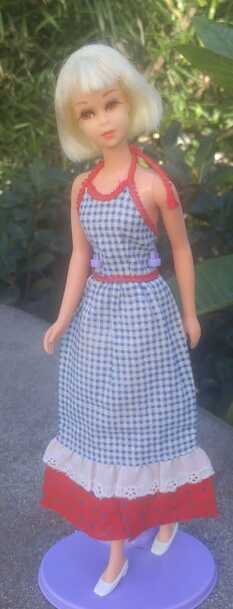 1970 Hair Happenin's Francie #1122 in Best Buy Fashion #8644 (1973) 1970 Hair Happenin's Francie #1122 in Best Buy Fashion #8644 (1973)
Francie Fairchild was a fashion doll issued by Mattel from 1966 to 1976 and re-introduced in 2011. Marketed as "Barbie's MODern cousin", the doll had an amazing line of "mod"-style clothing. Her fashions highlighted bright colors and geometric patterns similar to fashions associated with London's swinging Carnaby Street in the late 1960s. At 11¼ inches tall, Francie was shorter than Barbie, but taller than Barbie's little sister Skipper, making the character presumably between the two in age.
In the late 60s, Mattel wanted their Barbie line to better reflect the times. However, fearful of losing their core customer base, Mattel decided to produce a "test" doll first, and introduced Francie in 1966. She featured a body reflecting that of a young teen, with a flip hairdo, rooted lashes and a slight figure. Some believe that the Francie doll may have been based on the character "Gidget", whose real name was Frances Lawrence (sometimes called Francie). Francie was such a smash hit that she led the way for Barbie's makeover and MOD debut in 1967. Francie came in several models over her decade-long run, beginning with a straight leg model (1966–1968) who came in a red and white swimsuit and a "bend leg" doll (1966–1967) who was dressed in a geometric print swimsuit. "Twist 'N Turn" Francie was issued in 1967 and she could twist at the waist. She wore a striped one-piece swimsuit with pink bottoms. These three versions looked very similar. Then Francie was updated in 1969 with a short flip hairstyle and again in 1971 in a no-bangs hairstyle. All of these dolls were available in blonde or brunette and had rooted lashes, except for the straight leg dolls, who had painted lashes. In the 1970s, several hair-related variations of the Francie doll were issued: a blonde "Hair Happenin's Francie" (1970–1972), a blonde "Growin' Pretty Hair" Francie (1971–1973); and a brunette "Quick Curl Francie" (1973–1974). A tanned version, "Malibu Francie", was produced from 1971 to 1976 with blonde hair and blue eyes. She used the Casey head mold. "Busy Francie" (1972–1973) was a blonde doll designed with a hand that was able to grip small objects. 1975's brunette "Baggie Francie", so called because she was sold in a clear plastic bag as opposed to a box, was the last of the Francie dolls produced. This photo is of my 1970 Hair Happenin's Francie in the hard-to-find 1973 Best Buy Fashion #8644. She has a twist and turn waist, bendable knees, short blonde hair with bangs and a blue ribbon headband (my doll is missing the headband). She comes with four extra blonde hair pieces: Mini Curls, a topknot with large curls; Swingy Swirl, double flip curls on headband with an orange ribbon; Twisty Twirls, a braid on a headband with two banana curls and pink yarn bows and, lastly, Fluffy Whirl, a green riccon headband with short curls. Hair Happenin's Francie comes dressed in a blue dress with white crochet trim and aqua low heel shoes. The 1970 version has straighter hair while the 1971 and 1972 models have fluffier hair and paler lips. "Black Francie", first issued in 1967, was the first doll in the Mattel line with a dark complexion. But, the doll did not have stereotypical African American features, since it was made with the same head molds as the white Francie doll. Because of this, a doll named Christie, first issued in 1968, is often considered the first true African American doll in the Barbie line. A German variation of Francie (1972) was made with a different head mold, but the same body type as her US counterparts. Blonde-haired, blue-eyed German Francie was sold only in Germany and was only produced as a standard doll and a "Busy" variation. There are also Japanese variations of Francie and she was hugely popular in Japan. Japanese Francie and her exclusive fashions are the most valuable and sought after items amongst collectors. The rarest of all the Francie dolls is the Japanese Sun Sun Malibu Francie. She is a Malibu Francie with a deep suntan, and uses the original Francie head mold with rooted lashes and long brunette, side-parted hair. American-issued Francies used the Casey head mold, with blue eyes and blonde side-parted hair with no rooted lashes. The Japanese Francie dolls were produced in a very limited quantity so command a price of up to $4,000! Francie has been reproduced by Mattel three times: in 1996, as a brunette bend leg doll with a reproduction swimsuit and Gad-Abouts outfit; in 1997, as Black Francie (limited to 5,000 dolls) wearing a reproduction of The Wild Bunch; and in 2005, as a blonde, no-bangs Francie, wearing a reproduction of Smashin' Satin. Which Francie is your favorite?! Would love to hear from you, dolls!
Article source: Wikipedia 2014 #hairhappeninsfrancie #hairhappeninsbarbie #franciebarbie #70sfrancie #franciedoll #vintagefrancie #modfrancie  1967 Summer Sand Twist 'n Turn Barbie 1967 Summer Sand Twist 'n Turn Barbie Twist 'n Turn Barbie (#1160), also known as TNT Barbie, debuted in 1967. The 1965 American Girl Barbie doll was the first with bendable legs, but TNT Barbie was the first who could turn at the waist! She was a dynamite addition to the prior static dolls who didn’t twist. A pivoting waist added playtime fun and more pose options. She wore a salmon-colored bikini featuring a groovy net cover-up, and she kept the red fingernail and toenail polish that were a hallmark of earlier Barbie dolls. Check out her 1967 commercial! In response to rapidly changing styles and ideals of beauty, the Barbie face of 1959 wasn't relevant for the mod fashions dominating the fashion runways. Mattel's designers re-launched Barbie with a brand new look. Now featuring long, rooted eyelashes and a more youthful face, TNT Barbie was given a trendy hairstyle of straight chest-length hair with bangs. TNT Barbie’s new rooted lashes made her eyes as dramatic as those of Twiggy, the famous 60s British model. Mattel also made a Twiggy Barbie doll in 1967, its first doll based on a real person. The TNT doll's flowing straight locks got a boost in color and, for the first time, her super-shiny hair was given a description. Hair wasn't just blonde, brunette or titian (red). That wasn’t fashion-forward enough for a model! Now her hair came in Sun Kissed (light blonde), Summer Sand (grayish blonde - which I have in my collection, see side photo), Red/Titian (rare), Platinum (rare), Go Go Co Co (brownette), and Chocolate Bon Bon (dark brown).
In an interesting marketing move, Mattel initiated a trade-in promotion for the popular TNT Barbie. Mattel promised children they could exchange any old doll and pay $1.50 to acquire the all-new Twist 'n Turn Barbie. The trade-in dolls (#1162) were identical to regular TNTs, but they sealed in a plastic bag and packaged in a slim pink box. There's no doubt this was a turning point doll for Mattel. It was a departure from the doll's earlier more staunch, proper look. Pop culture strongly influenced Barbie doll fashions and attitude, which continued throughout Barbie history. The movin' groovin' world of the late '60s, with its mod haircuts, micro-minis, and moon boots, inspired Mattel designers to create a new line of clothes for Barbie and her teenage friends.
Sources: The Best of Barbie, Sharon Korbeck 2001; Barbie Doll Photo Album 1959 to 2009, J. Michael Augustyniak 2010 #tntbarbie #tnt #twistnturnbarbie #twistnturn #1967barbie #1968barbie #60sbarbie 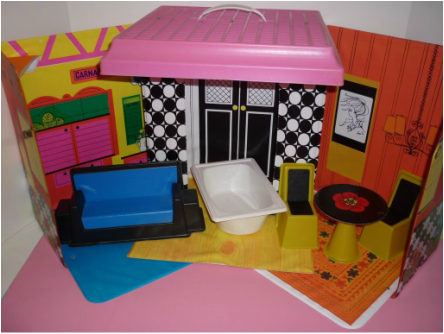 Barbie Family House #1066 Barbie Family House #1066
Barbie has lived in some pretty groovy homes over the years. Who wouldn’t want a “Dream House”? A reader of my blog was interested in learning more about Barbie houses and I thought it was a fantastic idea because I haven’t seen much written on this topic. So here is what I learned…
Barbie’s first home, built in 1961, was the “Barbie Doll Dream House” #0816. It’s the most common of all the Barbie cardboard structures. It unfolded into one big room that included a bedroom and living room. Barbie started the “open concept” home! Furnishings included cardboard items such as a twin bed, coffee table, TV, matching chair and ottoman, sofa, a vanity chair with a mirror, table lamp, books, a framed photo of her boyfriend Ken, and pillows. Barbie had records to play on her record player and she had quite the collection - Frank Sinatra, Nat King Cole, Kingston Trio and The Preps! My favorite, although not a home - is 1963’s Barbie Doll Fashion Shop #0817. I’m actually on the hunt for a minty one so let me know if you have one for sale! The shop includes a fun fashion stage where Barbie and her friends can try on and twirl around in new outfits. The next Barbie structure debuted in 1964, Barbie Goes To College #4093. Outside panels include scenes of a football stadium and game, and a drive-in movie theater. The interior view is a campus dorm room and a sweet shop - a place to meet friends for an ice cream float! Let’s fast forward to the Mod Era. The vinyl Barbie House Mate #5152 came out in 1966. The interior includes a plastic lavender sofa with end tables, ottoman, closet and attached turquoise floral print twin bed. That same year, the fold out Francie and Casey House Mate house #5092 was built. This structure’s interior has a built-in desk, gold plastic tub chair and pink plastic bed with a mod zebra-striped bedspread. Over the years, many more digs were built for Barbie, her family and friends. These structures included the 1966 Francie House #3302, 1966 - 1967 Barbie Family Deluxe Home, various World of Barbie Houses from 1966 - 1972, 1966 Francie and Casey Studio House #1026, and 1967 - 1968 Barbie and Francie Dressing Room Case #1024. There was a housing boom in 1970 because Barbie got a cute restaurant called Barbie Cafe Today #4983, Barbie Lively Livin’ Room, Barbie Teen Dream Bedroom #4985, and the Barbie Cookin’ Fun Kitchen #48987. Barbie had fun trying on new looks in her 1971 Unique Boutique Wig and Fashion Shop, and jetting off to Vail in 1972 to her Sears Exclusive Barbie Mountain Ski Cabin #4283. The Barbie Family House #1066 was produced from 1969 - 1972. This is the one I bought on eBay and am looking for ways to display my Barbies in it. The vinyl on this house is often cracked. Funny how over the years the 1960s cardboard Barbie houses endured better than the plastic ones in the 70s! From 1968 - 1976, there are many variations of the Barbie and Stacey Sleep ’N Keep Case. A Jamie Studio Apartment #4996 and a Jamie Party Penthouse #4990 came out in 1970. I have fond memories of the Barbie house I had as a little girl, the 1970 - 1972 Barbie Lively Livin’ House #4282. It was also called the Barbie Live Action House or Surprise House. It was a two floor, three room structure with three patios and four white patio fences. The patio panel can be flipped over and connected to the structure’s walls making more scenes on the other side of the house. My fellow Barbie blogger, Mary, has great photos of Barbie homes! What is your favorite Barbie house or structure? Would love to hear from you! #barbiedreamhouse #vintagebarbiedreamhouse #barbiehouses #barbielivelylivinhouse #barbieliveactionhouse #barbiemountainskicabin #franciecaseyhouse #barbiedollfashionshop #barbiehousemate #70sbarbiehouses 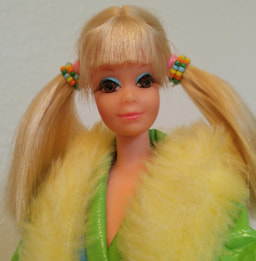 1969 New 'N Groovy Talking P.J. #1113 1969 New 'N Groovy Talking P.J. #1113
P.J. dolls are one of my favorite - I just love her adorable pigtails! She was introduced in 1969 as Barbie’s new best friend, replacing Midge… ouch! The first P.J. doll was marketed as “New ‘N Groovy Talking P.J.” She wore a pretty pink and orange floral dress and used the Midge face sculpt, but P.J. was more hip and mod. She had long blonde pigtails with beaded, colorful hair bands, brown doe eyes, pretty blue eye shadow and long rooted lashes. When you pulled the string on the back of her neck, she’d say fun things like, “Oh, you’re the grooviest!” and “Help me get ready for my date". Talking P.J. that still speaks is a real find for collectors! There are also Talking versions of Barbie, Christie and Ken. The second P.J. to arrive was the 1970 Twist ’n Turn P.J. in her cute pink swimsuit.
Live Action P.J., the third P.J. to be produced, was movin’ and groovin’! A special stand allowed P.J. to dance with the touch of the “touch and go” stand. Her box highlighted her many skills like, “I dance to your favorite music,” “I dance more than ever before,” “Start the action, touch my touch ’n go stand,” and “There’s lots I do - just like you.” The final P.J. of the Mod Era was 1972’s Sun Set Malibu P.J. She used the Steffie face sculpt and wore a fab lavender one-piece swimsuit. She joined her other tan friends, circa 1971, Malibu Barbie, Malibu Ken, Malibu Francie and Malibu Skipper. Beach pal Malibu Christie joined the squad in 1973. P.J. wore the same size clothes as Barbie so they could share closets. The only fashions that have a P.J. label are her swimsuits and the items from her two gift sets. Mattel tells us the initials P.J. don’t stand for anything, that it is simply her name. I find that odd so I like to think it stands for Penny Jane! What’s your guess?
Values from The Complete and Unauthorized Guide to Vintage Barbie Dolls, Hillary Shilkitus James, 2nd Edition, 2011 #pjdoll #pjbarbie #tntp.j. #liveactionpj #sunsetmalibupj #70spjdoll #barbiesfriendpj 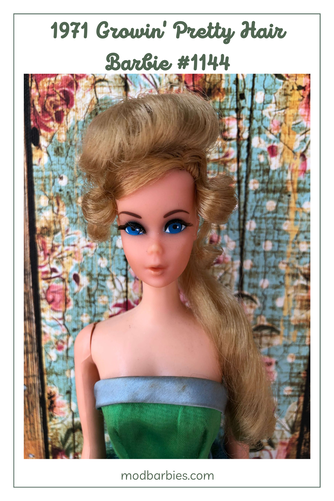
Growin' Pretty Hair Barbie is now with her friends in my collection! I was so excited to win this minty Barbie on eBay for just $95! Isn't she lovely? As a child, the reason I fell in love with Growin’ Pretty Hair Barbie was because I could lengthen or shorten her hair with a little tug! I thought this was ingenious. I also loved my Crissy doll for the same reason – do you remember her?! Growin’ Pretty Hair Barbie #1144 came with cute hairpieces – curls and braids – and accessories to complete her fun look. You could also style her blonde hair yourself with her little hair tools. The 1971 version was blonde with a side part, wore a pink dress and had pink ribbons on her hair accessories. The 1972 Growin' Pretty Hair Barbie wore a peasant / empire dress and the bow on her hairpieces was blue.The latter Barbie is worth more to collectors.
Baby dolls lost their popularity in the early 70s to fashion dolls like Barbie and Dawn. Children loved the hair play options with fashion dolls. Barbie’s retractable ponytail embraced this hair play craze. Aspiring hairstylists loved this Barbie because it provided hours of practice and dozens of hairstyle possibilities. Some children did more than just crimp and curl Barbie’s hair though. Barbie’s life span could be, umm… cut short with a deadly snip of scissors. Uh oh, now a real stylist had to be visited to fix the damage! It was a great idea for Mattel to sell a Barbie with many hairdo possibilities, rather than the somewhat surrealistic Hair Fair Barbie #4043 issued the same year. Hair Fair wasn’t even a doll! She was a head sold with accompanying wigs and accessories. However, in 1971 Mattel also released Hair Happenin’s Barbie #1174 who had hair options to add to her short, titian (red) hair. This Barbie was different than Barbie with Growin’ Pretty Hair because Hair Happenin’s came with red (titian) mini curls, midi swirls, and a fashion fall. She is considered by collectors as one of the most beautiful , rare and desirable dolls of the Mod Era. She can fetch upwards of $2,000 when Never Removed From Box! References: The Best of Barbie: Four Decades of America’s Favorite Doll, Sharon Korbeck (2001) Barbie: A Rare Beauty, Sandi Holder (2010) 1971 Growin’ Pretty Hair Barbie - Values: $300 - $375 NRFB; $150 - $225 mint/no box 1972 Growin’ Pretty Hair Barbie - Values: $475 - $550 NRFB; $275 - $350 mint/no box Values from "Vintage Barbie Dolls" by Hillary Shilkitus James (2011)
Live Action Barbie brings me back to when my mom went to Woodstock. In fact, this Barbie is often referred to as "Woodstock Barbie." I purchased Live Action Christie for just $99 on eBay. Isn't she gorgeous?! I was a little nervous because there was only one fuzzy photo of her on eBay. The seller said she was in very good condition but I'd say she's mint! Her head and hair were wrapped in cellophane and the outfit is perfect and complete. I'd say I scored on this one!
I've had Live Action P.J. and Live Action Barbie in my collection for a while so they're happy their last sister Christie joined them. Can you say Dance Party?!
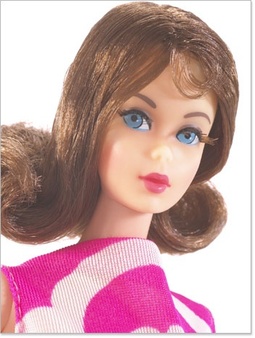 1970 TNT Barbie #1160 1970 TNT Barbie #1160 Ah, yes. The ever popular question, "How much is my Barbie doll worth"? I once read a Barbie is worth... whatever someone is willing to pay for her! I'm old school and start my research with Barbie reference books. The book I always reach for first is "Barbie Doll Photo Album - 1959 to 2009 Identification and Values." I find it has the best, most professional photographs for easy ID and the Barbie doll values seem comparable to the listings I see on eBay. I'm surprised to see a number of published Barbie ID books to have such out of focus and unprofessional photos. Were they taken with a 70s Polaroid? : ) Another good place to look for #BarbieValues is on eBay. You can "follow" Barbies to find out what they sold for. I set up a daily search so every morning eBay emails me all the new, vintage (wait, is that an oxymoron?!) Barbie listings that meet my criteria. To set up a daily alert, go to eBay.com and in the search bar enter Mod Barbies (or whatever you're looking for). Search results will appear. From there, in the top right corner, you'll see the word Advanced. Click on it and this is where you enter your search criteria. When done select Search. When your results show, right above the first doll, select Follow This Search. Then go to My Ebay/Searches You Follow/More Actions/Edit Email Options. Check the box that says, "Email me daily when new items match my search." Voila! It's a fantastic way to start your day with the latest Barbies you covet up for auction! The Internet posts a plethora of Barbie values as well. A good site is What is it Worth. Earliest Barbies from the late 50s and early 60s are the most valuable, and have shown the greatest value increases over the past 10 years, says a new index launched by justCollecting. Most valuable Barbies in the justCollecting Barbie Index 1. Barbie #1 Brunette (1959): $9,000 2. Barbie #1 Blonde (1959): $8,250 3. Barbie #2 Brunette (1959): $8,000 4. Barbie #2 Blonde (1959): $7,500 5. Roman Holiday Outfit (1959): $5,000 I learn a lot about Mod Barbies and values in Facebook groups such as Groovy Barbie, Crazy for Mod and Barbie & Friends Fashion Doll Guide. Group members share photos and stories, and post Mod Barbies for sale from their personal collections. It's a great forum to discuss our beloved obsession. Um... I mean hobby. : ) Where do you go to find Barbie values? I'd love to hear from you! xo, Lynne Hi Dolls! How's your summer so far? Are you indulging in fruity umbrella drinks with wide-brimmed hats and cool retro shades at the pool with a good book like me?! With the arrival of bikini season, I'm going to feature one of my favorite dolls (I know, I say that about all of them!) from my personal collection, Malibu Barbie's cousin, sun-kissed Malibu Francie #1068. And there is a rare brunette Japanese Sun Sun Malibu Francie also produced in 1971. The Sun Set Malibu group of tanned friends also included Malibu P.J., Malibu Skipper and Malibu Ken. In 1973, Malibu Christie #7745 was introduced and I thought she was one of the prettiest dolls I had ever seen. I was lucky enough that my family purchased all of these dolls for me! I grew up in Wisconsin, but with my strong affinity towards these dolls, I knew I was destined someday for SoCal. And voila, I've lived in San Diego for almost 20 years now! The introduction of the Sun Set family was an off the charts hit but, as Stephanie Deutsch (author of Barbie the First 30 Years) notes, it sadly marked the beginning of the end of the "Golden Time of Vintage Barbie dolls." The following mass-produced, low-budget Barbies lacked the quality (lashes, elaborate hairstyles) and flair of the early Barbie dolls that collectors love so much. 1971 Sun Set Malibu Francie - Values: $175 - $225 NRFB; $50 - $75 mint/no box
Values from "Vintage Barbie Dolls" by Hillary Shilkitus James (2011)
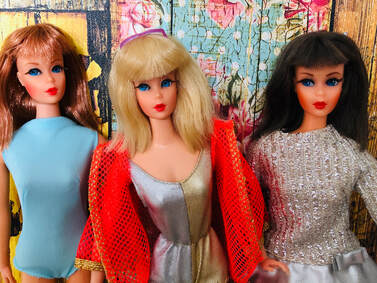 Titian red, blonde and brunette New Dramatic Living Barbies Titian red, blonde and brunette New Dramatic Living Barbies In 1970, Mattel introduced the first fully posable Barbie doll, Dramatic New Living Barbie. She could tilt her head, bend her knees and elbows, pose her ankles, rotate her wrists, swing her arms and swivel at her waist. She could even do the splits! She was available in blonde, titian red or brunette hair (see below) and wore a beautiful gold and silver metallic one-piece suit with an orange fishnet cover-up. In 1971 "New" was dropped from her name and was shortened to "Dramatic Living Barbie." She was packaged in a new box and came in a polka-dotted swimsuit with a matching wrap. Another difference between the two is that the 1970 doll had side glance eyes whereas the 1971 doll had centered eyes. Dramatic New Living Barbie's advertisement touted that she "twists left and right and bends at the waist like a willow." Huh? Bends like a tree? No matter, I had hours of fun with these two! She has pretty, extra-long lashes (no falsies here!). These dolls aren't super-popular with collectors unless it's a Living Barbie produced in Japan rather than Taiwan. I tried reading the stamps on the bums from my collection but my old eyes cannot decipher the small imprint! I watched an eBay bid for a Dramatic Living Barbie (1969) today and it sold for $184 NRFB, and another mint/no box 1970 Dramatic Living Barbie which went for $89 - both great deals for the winners! 1970 Dramatic New Living Barbie - Values: $260 NRFB; $120 mint/no box 1970 Dramatic New Living Skipper - Values: $110 NRFB; $60 mint/no box Values from "Vintage Barbie Dolls" by Hillary Shilkitus James (2011) 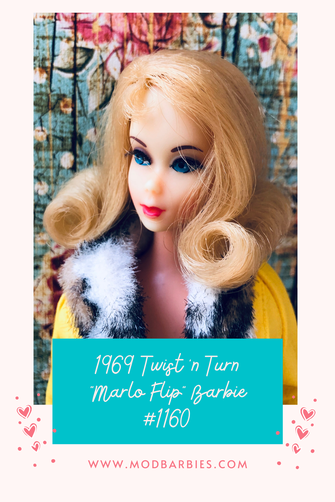 Hi Dolls! I'm just starting out with my Mod Barbie blog and decided to share photos of Barbies in my personal collection and a bit of their history. This post features Twist 'N Turn Barbie #1160. She got a new look in 1969; a new hairstyle, the "Marlo" flip style... a shoulder length flip, inspired by the hit TV show "That Girl" which aired from 1966 to 1971. I remember it being one of my grandma and my favorite TV shows - along with Laugh In! This Barbie is often referred to as TNT Flip or TNT Marlo. She wore a new diamond-print one-piece swimsuit with a yellow collar. Values: $525 - $600 NRFB; $285 - $375 mint/no box; $175 - $300 average She's wearing Loop Scoop #1454 (1970). This sleeveless, yellow cotton dress features a skirt with colorful rows of braids below the dropped waist. The dress has built-in panties and comes with yellow chunky shoes. This outfit in mint condition is worth $125. I also have the 2007 Red White 'n Warm Vintage Barbie Reproduction doll which features the TNT Barbie doll with a flip hairstyle. It is a Gold Label Collectible Barbie doll (limited to 11,100 dolls worldwide) from the Vintage Barbie Reproduction Collection. She's wearing a reproduction of the Mod ensemble, Red White 'n Warm #1491 (1969 - 70). It includes a white vinyl coat with faux fur, a fur trimmed hat and white boots w/ gold ankle chains. Underneath it is a sleeveless color block dress in orange and hot pink. The original outfit in mint condition is worth $250. Barbie's fashions in 1969 were super mod minis, midis and maxis in bright colors and crazy prints. Barbie's wardrobe also fit her friends Christie, Julia and Stacey. 1969 brought Barbie 36 new outfits and 16 that were repeated from 1968. Values from "Vintage Barbie Dolls" by Hillary Shilkitus James (2011) 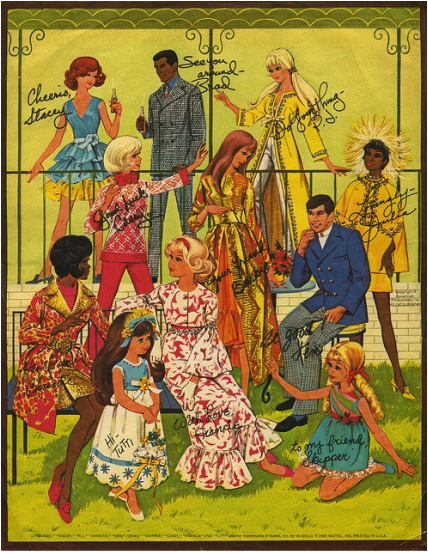 Barbie's history Barbie's history It sure can be confusing figuring out Barbie’s genealogy! So I pulled together a list from various sources to come up with a quick cheat sheet of how the Barbie family and friends are related to one another. And if you’re particularly interested in a particular doll, check out the individual tabs under “Barbie & Friends” (coming soon)! Their stories are a work in progress for me but, as I discover more, I will continually add to these pages. * The year denotes when the doll was created. Barbie Millicent Roberts (1959) – The first Barbie doll was described as a “Teen Age Fashion Model” and her parents’ names are George and Margaret Roberts. Barbie grew up in fictional Willows, Wisconsin. (I love this little fun fact since I also grew up in Wisconsin!) Midge Hadley Sherwood (1963) – She was Barbie’s best friend and the third character introduced to the Barbie line, following Barbie and Ken. She was paired with Allan Sherwood, Ken’s best friend, when Allan was introduced in 1964. Skipper Roberts (1964) – Skipper was the first character added to the line as part of Barbie doll’s family. Skipper is Barbie’s younger sister. Skipper’s best friend’s name was Skooter (1965) and Skipper’s boyfriend was Ricky (1965). Tutti and Todd Roberts (1965) – Younger twin sister and brother to Barbie and Skipper. Tutti and Todd had a female friend named Chris (1967). Francie Fairchild (1966) – Francie is Barbie’s cousin. In the March 1966 issue of Barbie Magazine, Francie was the daughter of Claude and Lily Fairchild. Some believe that the Francie doll may have been based on the character “Gidget,” whose real name was Frances Lawrence (sometimes called Francie). Francie was such a smash hit that she led the way for Barbie’s makeover and MOD debut in 1967. Casey (1967) – The second doll in Francie’s size, Casey, was issued as “Francie’s Fun Friend.” Twiggy (1967) – Twiggy was based on the famous fashion model, Lesley Hornby Lawson, of the Mod era. Twiggy resembled Casey but with heavier painted-on makeup. The Twiggy doll was made through 1968, and Casey through 1970. Stacey (1968) – Stacey was Barbie’s “British chum,” part of the new group of Talking dolls in 1968. She was later issued as a Twist ‘N Turn version. These are the only two types of Stacey dolls ever made. Christie (1968) – Christie was Barbie’s first African-American friend. P.J. (1969) – P.J. was a friend of Barbie’s and initially marketed as “New ‘N Groovy Talking P.J.” To date, Mattel has declared that the initials P.J. don’t stand for anything, that it is simply the character’s name. Julia (1969) – She was based on Diahann Carroll’s character from the TV show Julia. Jamie (1970) – Walking Jamie was a Sears exclusive doll. Steffie (1972) – She was available as Busy Steffie, Talking Busy Steffie, and Walk Lively Steffie. Though the character was discontinued after only a year, she is notable in that none of the three Steffie dolls featured the same eye color/hair color combination. 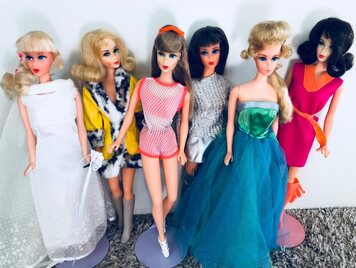 Mod Barbies from the 60s and 70s Mod Barbies from the 60s and 70s Hi Dolls! I’m Lynne and I’ve been into Barbies for as long as I can remember! I’ve been collecting vintage Barbies for a few years now. I decided to create a Barbie site and blog focusing on my favorite years ~ the MOD era from 1967 – 1972. My friends tease me about my Barbie passion (obsession?!) I’ve discovered a lot about Barbie over the years, and I’d like to share my knowledge with you. As I’ve been researching Barbie and her friends, I wasn’t able to find the information I was looking for in one place. I was pouring through books and guides, and searching online for hours. My goal is to provide an easy to navigate, one-stop forum where we can share our Barbie stories, thoughts and photos. And, well, to just talk Barbie! I’m going to provide Barbie news, Barbie doll values, history, doll and fashion info, and more! As I’m developing this site, I’m very interested in the types of things you’d like to read about regarding Barbie and her friends. You can reply to this blog or email me at [email protected]. I will leave you with an interesting tidbit about us collectors. “Mattel estimates that there are well over 100,000 avid Barbie collectors. Ninety percent are women, at an average age of 40, purchasing more than twenty Barbie dolls each year. Forty-five percent of them spend upwards of $1,000 a year.” I will admit that I fall into that category, haha. What about you? Let’s talk! xo, Lynne |
Search for any Barbie or other 70s doll blog posts in the box below!
Categories
All
Archives
May 2024
|
|
Find your
Mod Barbie on eBay! Visit https://ebay.us/RkAlda. |
